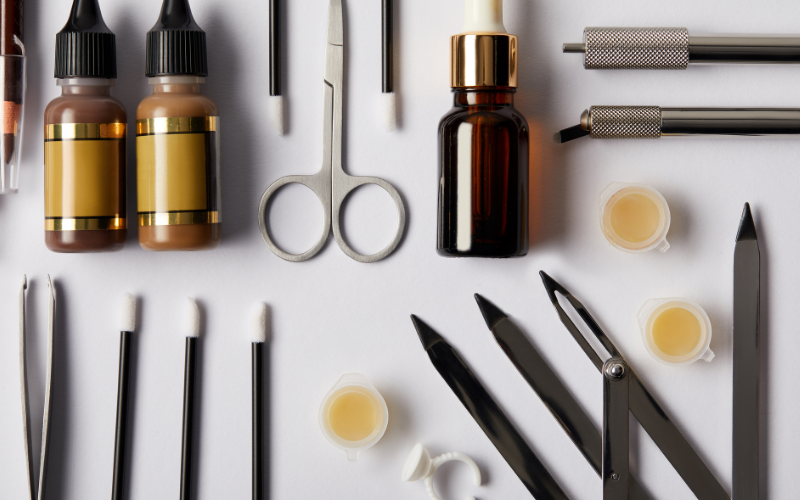Laser Hair Removal
Hair In All The Wrong Places?
Unwanted hair can be a pesky confidence buster. Whether you were born with hairy toes or are experiencing hormone changes that are causing hair to grow where it shouldn’t, taking that first step to remove unwanted hair for the long term can drastically change the way you feel about yourself and your life.
Over the course of their lives, women spend a total of 72 days shaving their legs. For men, the total days shaving is 45. Yet they shave, wax, pluck and repeat, week after week, enduring rough stubble, ingrown hairs, irritated skin, and various nicks and cuts. Waxing is another way to remove unwanted hair in different places, but it still requires regular trips to the spa every few weeks.
Ditch your razors, tweezers, and hot wax for something better and more permanent. With Avec Elle Beauty Bar’s laser hair removal services, there’s no need to worry about rough stubble, ingrown hairs, irritated skin, and various nicks and cuts. This hair removal method provides individuals with healthier, smoother skin and improved confidence for a long time.
Some of the most common treatments include:
- Bikini lines
- Legs
- Stomach
- Shoulders
- Face
- Chin
- Upper lip
- Back
- Underarms
- Neck
- Arms
- Sideburns
How does laser treatment work?
Lasers emit a wavelength of light with a specific single colour. When targeted to the skin, the energy from the light is transferred to the skin and hair pigment melanin. This heats up and damages the surrounding tissue.
But to remove hair permanently and to minimise damage to the surrounding tissue, the laser needs to be targeted to specific cells. These are the hair follicle stem cells, which sit in part of the hair known as the hair bulge.
The laser needs to be targeted to stem cells that sit in the hair bulge.
As the skin surface also contains melanin, which we want to avoid damaging, people are carefully shaved before treatment.
Will it remove it permanently?
Laser treatment can either permanently reduce the density of the hair or permanently remove unwanted hair.
Permanent reduction in hair density means some hairs will regrow after a single course of therapy and patients will need ongoing laser treatment.
Permanent hair removal means none of the hairs in the treated area will regrow after a single course of therapy and no ongoing laser therapy is needed.
Whether hair is removed permanently or just reduced in density is influenced by:
• the color and thickness of the hairs being treated
• the color of the patient’s skin
• the type and quality of the laser used
• the competence and training of the person operating the laser.
However, if you have grey hairs, which have no melanin pigmentation, currently available lasers don’t work.
How many treatments will I need?
The number of treatments you’ll need depends on your Fitzpatrick skin type. This classifies your skin by colour, its sun sensitivity and its likelihood to tan.
Pale or white skin, burns easily, rarely tans (Fitzpatrick types 1 and 2) People with dark hair can usually achieve permanent hair removal with 4-6 treatments every 4-6 weeks. People with fair hair will generally only achieve permanent hair reduction and after an initial course of treatment may need 6-12 treatments a month apart.
Light brown skin, sometimes burns, slowly tans to light brown (type 3) People with dark hair can usually achieve permanent hair removal with 6-10 treatments every 4-6 weeks. People with fair hair will generally only achieve permanent hair reduction and after an initial course of treatment may require 3-6 repeat treatments a month apart.
Moderate brown to dark brown skin, rarely burns, tans well or to moderate brown (type 4 and 5) People with dark hair can usually achieve permanent hair reduction with 6-10 treatments every 4-6 weeks. Maintenance will usually be required with 3-6 monthly repeat treatments.
People with fair hair are unlikely to respond.
Re-treatments must be long enough apart to allow new hair growth to reach the level of the bulge.
What are the side effects?
You will be advised to wear goggles during the treatment to prevent eye injury.
You will also experience some pain during treatment, especially the first few. This is mainly due to not removing all hair in the area to be treated before the procedure. Hairs missed while shaving absorb laser energy and heat the skin surface. There is less pain with repeat treatments at regular intervals.
Your skin will feel hot for 15-30 minutes after laser treatment. There may be redness and swelling for up to 24 hours.
More serious side effects include blisters, too much or too little skin pigmentation, or permanent scarring.
These generally occur in people with a recent suntan and the laser settings have not been adjusted. Alternatively, these side-effects can occur when patients are taking medications that affect their skin’s response to sunlight.
Does the type of laser matter?
The type of laser not only influences how well it works, it influences your chance of side-effects.
Lasers suitable for hair removal include: long-pulse ruby lasers, long-pulse alexandrite lasers, long pulse diode lasers and long-pulse Nd:YAG lasers.
Intense pulsed light (IPL) devices are not laser devices but flash lamps that emits multiple wavebands of light simultaneously. They work in a similar way to lasers, albeit less effectively and they are much less likely to permanently remove hair.
To minimise the risk of damage to melanin producing cells on the skin surface, the choice of laser and how it’s used can be matched to your skin type.
Fair skinned people with dark hair can use an IPL device, an alexandrite laser or a diode laser; people with dark skin and dark hair can use a Nd:YAG or diode laser; and people with blond or red hair can use a diode laser.
To control the spread of heat and unwanted tissue damage, short laser pulses are used. The energy of the laser is also adjusted: it needs to be high enough to damage the bulge cells but not so high to cause discomfort or burns.
IPL Treatment
IPL stands for Intense Pulsed Light, and is sometimes referred to as a photofacial. During this procedure, a handheld device is passed over targeted areas of the skin, sending a flash of light deep into the skins layers. The energy and wave lengths in this light breaks up any unwanted pigment, creating a more even skin tone.
What does IPL treat?
• Sun spots
• Rosacea
• Freckles
• Acne Reduction
• Age (liver) spots
• Birthmarks
• Dark Stretch Marks
• Can also improve skin’s texture
Is there any downtime?
Barely! You can go about your normal routine immediately after, however it is recommended that you stay out of the sun in the two weeks before and after your treatments. In the days following your IPL procedure, your skin may feel and look slightly like a sun burn, but will quickly dissipate.
Dark spots on the skin may become slightly darker during the healing time. While you heal, it is recommended that make up on the face not be used, but a moisturizer and SPF be applied daily.
Who is a good candidate?
Fitzpatrick skin types 1-4 are recommended for IPL Treatments.
IPL treatments are NOT recommended if:
• You are pregnant
• Have an active tan (from the sun in the past 14 days or have been exposed to a tanning bed or tanning creams)
• Might have skin cancer
• Are sensitive to light
• Are Fitzpatrick type 5 or 6
• Have severe or keloid scars
• Use a retinoid cream
How many sessions are needed?
While you will see improvement after only one session, most people need about 4-6 sessions in order to obtain their skin’s goals. You must wait 2-4 weeks between each session.
IPL will treat current damaged skin, but doesn’t prevent future damage. Using SPF and moisturizer daily helps to keep your skin looking and feeling it’s best.
Does it hurt?
Similar to most laser techniques, an IPL treatment feels like a rubber band being slapped against your skin.
How much does it cost?
Depending on the surface area, an IPL can cost anywhere from $250 – $1000. Discounts are available when multiple sessions are booked.
Ask us about our payment options!
Erbium Skin Resurfacing
The erbium laser safely removes a layer of skin to a depth determined by your technician. The depth of treatment will depend on the skin condition, your desired outcome and expectation for downtime. Treating skin with a laser stimulates the growth of new collagen, which improves the skin’s thickness and resilience. The skin surface will also re-grow with fresh, healthy cells, giving your skin a younger, rejuvenated appearance.
What does it treat?
This procedure can really hone in on those pesky fine lines and wrinkles as well as sun damage and overall poor skin tone and texture.
Is there any downtime?
Most clients should expect a 4-5 day downtime for shallow treatments. If you generally take longer to heal, slightly longer can be expected for this as well. If getting a deeper treatment, we will discuss more realistic downtime expectations per client. During this time you will experience scabbing and should stay out of the sun.
Who is a good candidate?
Fitzpatrick skin types 1-4 are recommended for Erbium Skin Resurfacing.
Erbium Skin Resurfacing treatments are NOT recommended if:
• You are pregnant
• Have an active tan (from the sun in the past 14 days or have been exposed to a tanning bed or tanning creams)
• Might have skin cancer
• Are sensitive to light
• Are Fitzpatrick type 5 or 6
• Have severe or keloid scars
• Use a retinoid cream
How many sessions are needed?
Generally only one session is needed to achieve the desired results.
Erbium Skin Resurfacing will treat current damaged skin, but doesn’t prevent future damage. Using SPF and moisturizer daily helps to keep your skin looking and feeling it’s best.
Does it hurt?
Similar to most laser techniques, an Erbium Skin Resurfacing treatment feels like a rubber band being slapped against your skin. A topical anesthetic is used to help alleviate any unwanted pain.
How much does it cost?


